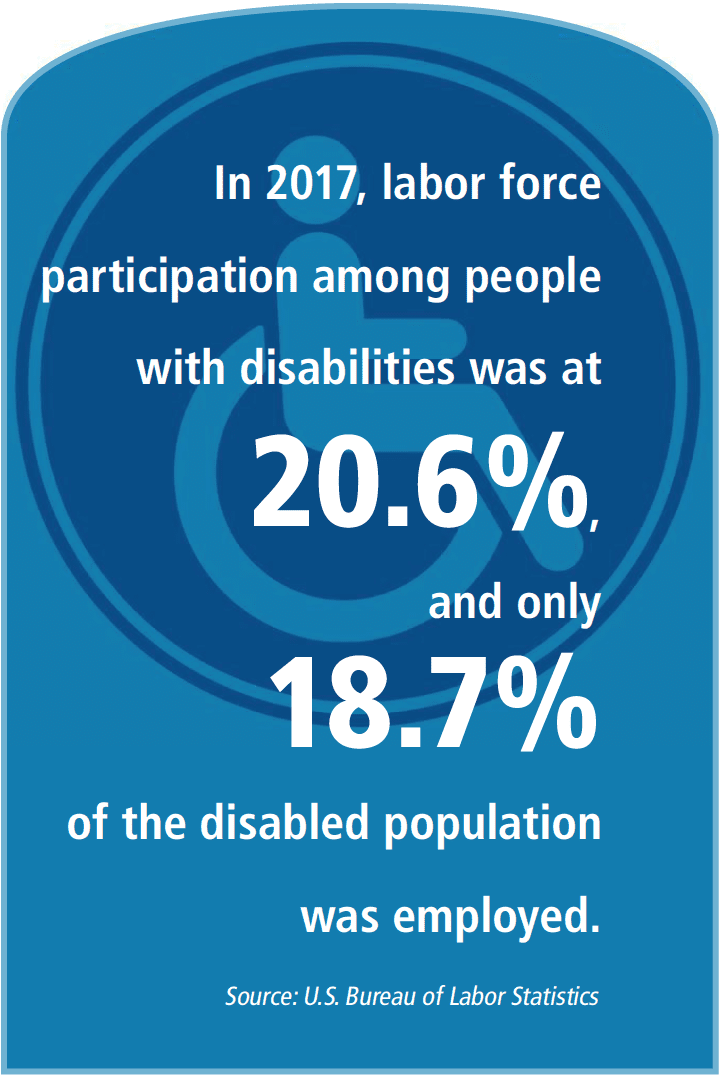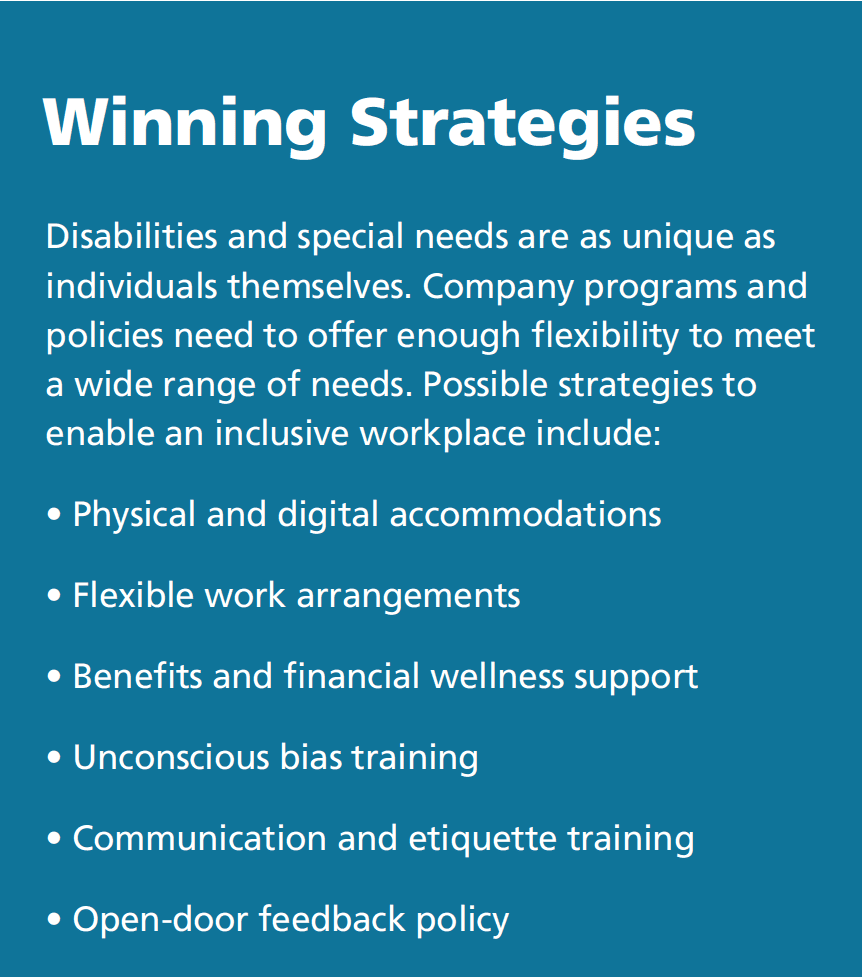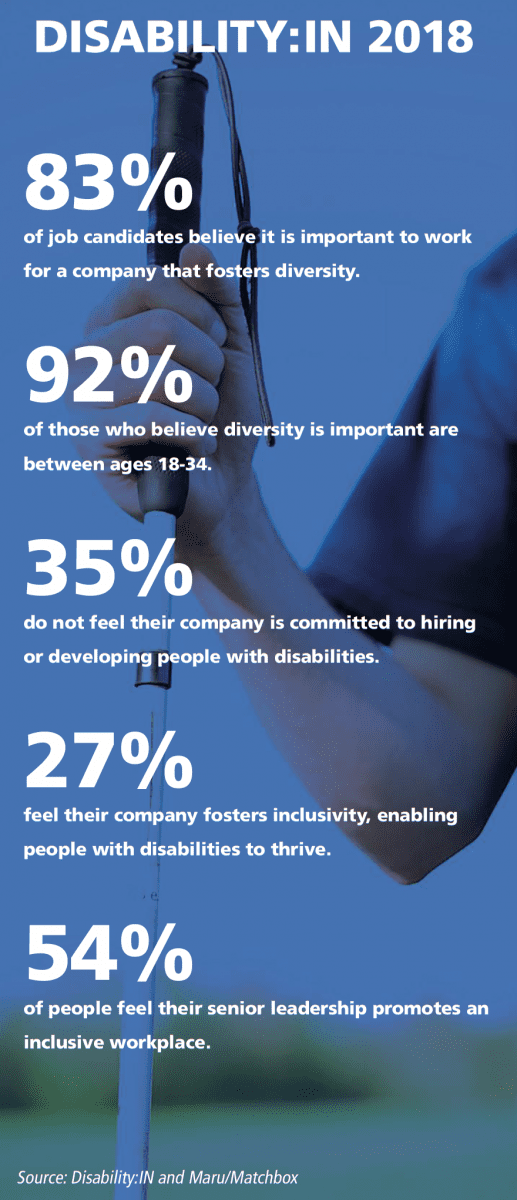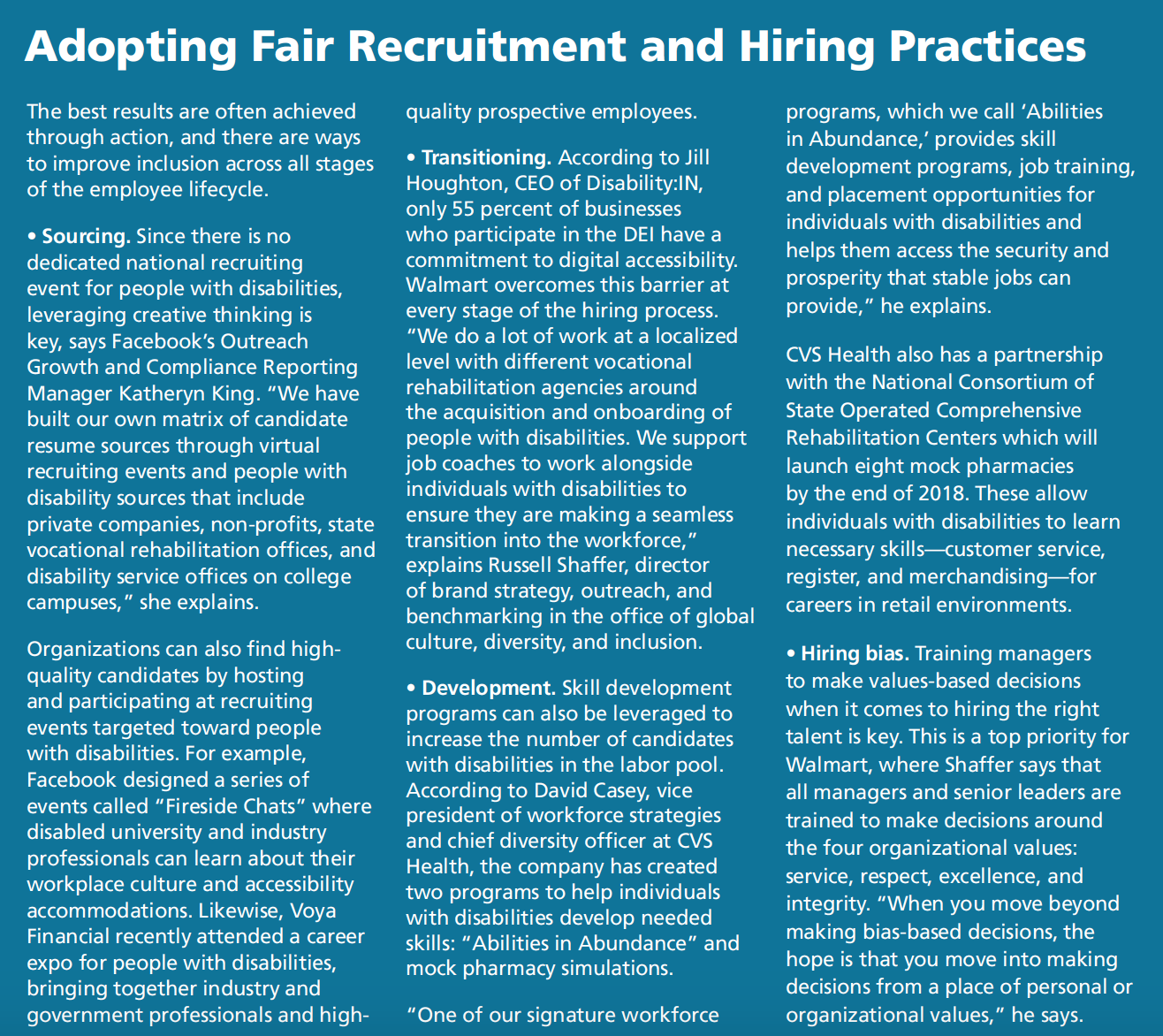What do Facebook, Walmart, CVS Health, and Voya Financial have in common? A strong disability inclusion program.
By Marta Chmielowicz
Twenty-eight years ago, the Americans with Disabilities Act (ADA) was signed into law. Prohibiting discrimination against people with disabilities and calling for reasonable accommodations for all who need them, this piece of legislation was a landmark victory in the fight for civil rights and equal opportunities.
“Many of our fellow citizens with disabilities are unemployed,” said President George H. W. Bush as he signed the bill. “They want to work and they can work… Together, we must remove the physical barriers we have created and the social barriers that we have accepted, for ours will never be a truly prosperous nation until all within it prosper.”
Today, the former president’s words are still as relevant as ever. The U.S. Bureau of Labor Statistics reports that in 2017, labor force participation among people with disabilities remained low at 20.6 percent, with only 18.7 percent of the disabled population employed.

“Disability:IN is really the intersection of where professionals with disabilities and businesses come together,” says Jill Houghton, the organization’s CEO. “We’re here to empower business to advance disability inclusion and equality.”
The Business Case
Hiring individuals with disabilities delivers significant business benefits. “When people are able to bring their whole selves to work, you’re able to minimize what neuroscientists call the ‘social pain of exclusion,’ helping ensure that people are able to be their most productive, optimized self,” says Russell Shaffer, Walmart’s director of brand strategy, outreach, and benchmarking in the office of global culture, diversity, and inclusion.
The “social pain of exclusion” refers to the phenomenon that social rejection activates many of the same regions of the brain as physical pain. By helping individuals with disabilities feel included, the Vice President of Workforce Strategies and Chief Diversity Officer at CVS Health David Casey says that organizations can gain workers who are dependable, loyal, and more easily retained. According to Shaffer, more inclusive practices also create a safe environment that promotes strong connections between employees and their peers as well as the organization, leading to better performance, higher engagement, and greater innovation.
This increase in innovation can even result in a more thoughtful and accessible product. Katheryn King, outreach growth and compliance reporting manager at Facebook, says, “We believe that with a diverse workforce, we can better serve the people from all backgrounds who use our products. There are over one billion people with disabilities in the world. We want to make sure that we are building products that are accessible to them and serve their unique needs… Employees with disabilities not only have value in driving product accessibility but also in problem-solving and bringing diverse perspectives to innovation and creativity.”
In fact, Facebook can attest to the value of their special needs employees’ unique perspectives for product development; the company’s automatic alt text (AAT) functionality, which uses object recognition technology to create descriptions of photos for the blind community, was developed by a blind engineer.
Taking advantage of the talents and perspectives of workers with disabilities allows organizations to expand their customer base while inspiring their employees and customers alike. “By making a greater effort to hire employees with disabilities, we have gained broader insight into the community and have been able to better connect with our customers living with special needs and disabilities as well as their caregivers,” says Kevin Silva, CHRO of Voya Financial. “It’s become clear very quickly that everyone, including our employees and customers, has a connection to someone with a disability in some way.”
Getting Started
One thing is clear: Disability inclusion has moved from a compliance-centric issue to a business differentiator. Organizations experiencing success have aligned inclusion with their core foundational values, essentially integrating it within the DNA of the company. To begin the journey toward an inclusive culture, HR professionals can consider three best practices:
1. Align inclusion with the company’s mission. While companies can experience good results by introducing disability-minded practices, true inclusion can only occur when the goals of the program are echoed by the mission and goals of the organization.
According to Silva, this is something that Voya Financial has fully embraced. “Our disability inclusion efforts encompass our corporate value of doing the right thing -it’s embedded in our DNA and a necessary obligation to our customers, employees, and communities,” he says.
How does Voya do this? Disability inclusion is realized in the “Voya Cares” program, which works to help the disabled community by:
- raising internal disability awareness;
- providing employee education;
- cultivating a culture of inclusion; and
- promoting inclusion efforts as part of Voya’s core values.
To date, 106 employees have received training to integrate “Voya Cares” into the business.
2. Establish a cross-functional team. Houghton says that organizations that establish enterprise-wide teams to bring together the perspectives of talent acquisition, procurement, real estate, marketing, and technology teams can better understand current accessibility roadblocks and opportunities.
CVS Health, for example, has a specific workforce initiatives team that is responsible for driving strategy and partnerships to advance the status of employees with disabilities -as well as youth, veterans, and mature workers -within the company. “Our team is structured so that we have a dedicated team member for each state which helps educate our CVS Pharmacy field teams and other parts of the business, and connects them to partners that we work with in the community,” Casey explains. “Our workforce initiatives team partners with state and federal workforce agencies to provide employment services and training to underserved communities all across the country.”
3. Choose a champion. Another best practice is the appointment of a senior champion who can share their personal experience with disability. “[Companies who are just getting started should] identify a senior leader that either is willing to be authentic and talk about being a person with a disability or perhaps an ally -maybe as a parent of a young person with a disability or a spouse or family member. Identifying a senior leader that is willing to champion this issue and gaining that support is important,” Houghton says.

This strategy has been successful at Facebook, where King says a software engineer was motivated by an internal awareness campaign to share his story of having bipolar disorder. He is now an active advocate for Facebook’s workplace culture on the organization’s recruiting panels and even at a national conference.
Communication also helps increase the visibility of leadership support. Shaffer says that Walmart has a CEO-hosted inclusion forum where all levels of employees can share their experiences. This coupled with regular messaging from the chief disability officer around topics of diversity gets the word out.
Enabling a Culture of Inclusion
While there are many ways that companies can encourage greater inclusivity across the employee lifecycle, an organizational culture of inclusion builds a foundation so that people with disabilities feel welcome and valued. There are a few steps organizations can take to create this culture of acceptance.
• Benchmark. First, HR leaders need to evaluate their existing culture compared to industry leaders. A helpful tool for benchmarking against the top-performing companies is Disability:IN’s “Disability Equality Index (DEI).” “The DEI looks at things like culture and leadership, enterprise-wide access, employment practices, community engagement, supplier diversity, and non-U.S. operations. It really encourages HR leaders to dig in across the company,” says Houghton. Organizations can use the index as an assessment of their current performance and find areas in which they can improve.
For Facebook, participating in the DEI was an efficient way to audit the entire scope of the company’s disability inclusion policies. According to King, “The DEI was a way for us to survey Facebook’s policies, procedures, and processes for people with disabilities by examining the work done to date. It was an opportunity to recognize our accomplishments and help plan our future road map to serve our current and future employees with disabilities.”

• Feedback. How can companies further gauge their performance when it comes to disability inclusion? While benchmarking is a solid technique, another great resource is employees. By holding employee focus groups and creating an environment of transparency and communication, organizations can empower individuals with disabilities to step forward and become part of the solution.
“Companies can ensure they are filling the needs of an individual with disabilities the same way they do with all of their colleagues -through strong two-way communication, listening, and understanding,” says Casey.
• Representation. Employee resource groups are another essential resource for companies working to create an inclusive workplace. These groups allow employees to find support and lead the way to change, engaging with leadership and developing their own inclusion initiatives.
Facebook, Voya Financial, and Walmart all recognize the value of community resource groups. For example, Differently Abled@ (DA@), Facebook’s group for people with disabilities, meets regularly through a product called Workplace where they can create public or private forums to share their perspectives and express their needs.
Internal awareness campaigns can work hand-in-hand with resource groups to dispel misconceptions about people with special needs. “For example, the #ThisIsMe internal campaign focused on increasing disability awareness and dispelling myths associated with disability self-identification through storytelling,” says King.
Likewise, the newly created Disabilities and Special Needs Employee Resource Group (ERG) at Voya Financial, with more than 300 members, allows employees to take ownership of efforts to serve and employ those with special needs. In fact, in honor of National Disability Independence Day, the Disabilities and Special Needs ERG produced a pamphlet, “Tips for Interacting with People with Disabilities,” that was distributed to the entire workforce, says Silva.
• Mentorship. One strategy that Disability:IN finds especially valuable for creating a supportive work environment and building on prior progress is their mentorship exchange program. According to Houghton, “We really believe in the power of mentoring, so we start with our partners and we identify mentors -most of which sit in a wide variety of places within corporate America, and some of which are professionals with disabilities. We are engaging disabled leaders to turn around and mentor young next-gen leaders, paying it forward for them.”
Voya piloted Disability:IN’s “Mentorship Exchange” program in 2012. Since the launch, there have been more than 600 mentee/mentor matches, and more than 50 percent of mentees from the 2016 program were working full- or part-time jobs by the end of the year.
Walmart has taken mentorship so far that it is starting to leverage technology to truly optimize the experience. By adopting technology that matches mentors with mentees and utilizing community-based platforms to build mentoring circles and circulate curated content, Shaffer says that Walmart is looking to secure deeper connectivity and a seamless, more engaged experience.
“For our director level and above, those leaders have what is called inclusive leadership expectations,” explains Shaffer. “Within those expectations, leaders are expected to participate in at least one inclusion education experience throughout the year. They’re also expected to mentor at least two individuals and/or lead a mentoring circle. There’s a degree of expectation that they’re participating in activities that help broaden their perspective.”
• Education. When it comes to disability-related education and training initiatives, Voya Financial leads the way. “As with anything else, we always start with educating our employees,” explains Silva. “We need to make sure that our employees are knowledgeable and confident about interacting with a person with a disability. Otherwise, we will lose out on a huge talent pool right from the start.”
To this end, Voya developed a “Introduction to People with Special Needs Planning” training course for all employees that covers appropriate nomenclature, titling, government benefits, and the legal aspects of special needs planning. In addition, Voya also recently held two training sessions for HR staff and hiring managers conducted by Disability:IN. Participants learned tips on how to interact with individuals with disabilities.
But Voya is not alone -Walmart also offers a 90-minute disability-centric bias disruptor session called “Dining in the Dark,” an experiential session where employees partake in a dining experience as someone who is blind and someone with a sighted guide.
Disability inclusion is a complicated issue that requires action across all parts of the business -not just HR. But for companies that are able to do it right, the rewards are significant. Organizations have the opportunity to see greater employee innovation, stronger interpersonal relationships, and deepened trust in the workplace. From helping communities to enhancing company culture, there is no doubt that accepting people with disabilities into the workplace will be the new norm -and companies should get a head start.















